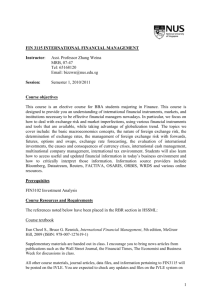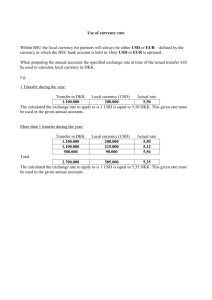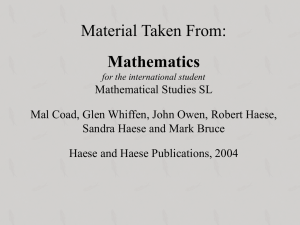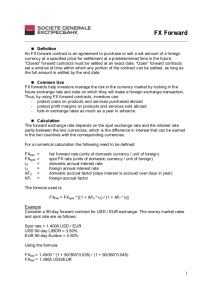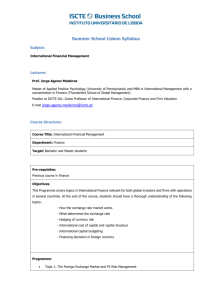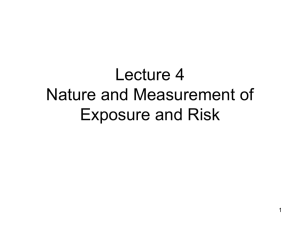Aussie Dollar Barometer - Commonwealth Bank of Australia
advertisement
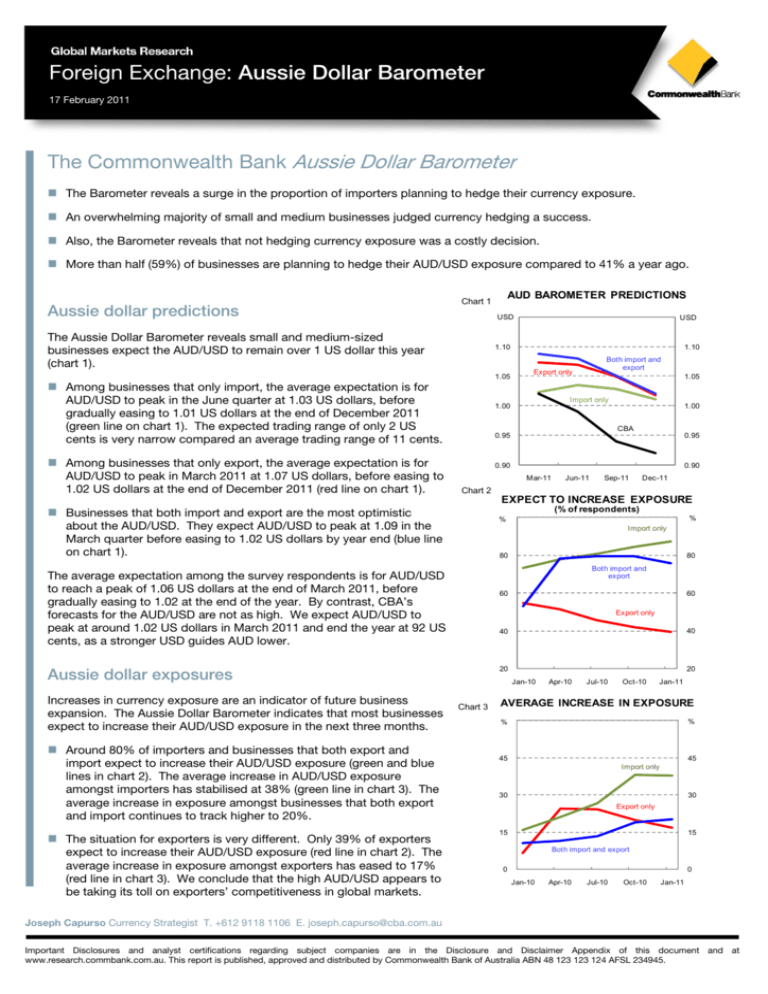
Foreign Exchange: Aussie Dollar Barometer 17 February 2011 The Commonwealth Bank Aussie Dollar Barometer The Barometer reveals a surge in the proportion of importers planning to hedge their currency exposure. An overwhelming majority of small and medium businesses judged currency hedging a success. Also, the Barometer reveals that not hedging currency exposure was a costly decision. More than half (59%) of businesses are planning to hedge their AUD/USD exposure compared to 41% a year ago. Aussie dollar predictions Chart 1 USD The Aussie Dollar Barometer reveals small and medium-sized businesses expect the AUD/USD to remain over 1 US dollar this year (chart 1). USD 1.10 1.10 1.05 Among businesses that only import, the average expectation is for AUD/USD to peak in the June quarter at 1.03 US dollars, before gradually easing to 1.01 US dollars at the end of December 2011 (green line on chart 1). The expected trading range of only 2 US cents is very narrow compared an average trading range of 11 cents. Both import and export Export only 1.05 Import only 1.00 1.00 CBA 0.95 0.95 Among businesses that only export, the average expectation is for AUD/USD to peak in March 2011 at 1.07 US dollars, before easing to 1.02 US dollars at the end of December 2011 (red line on chart 1). AUD BAROMETER PREDICTIONS 0.90 0.90 Mar-11 Jun-11 Sep-11 Dec-11 Chart 2 EXPECT TO INCREASE EXPOSURE Businesses that both import and export are the most optimistic (% of respondents) about the AUD/USD. They expect AUD/USD to peak at 1.09 in the March quarter before easing to 1.02 US dollars by year end (blue line on chart 1). Import only Both import and export import expect to increase their AUD/USD exposure (green and blue lines in chart 2). The average increase in AUD/USD exposure amongst importers has stabilised at 38% (green line in chart 3). The average increase in exposure amongst businesses that both export and import continues to track higher to 20%. The situation for exporters is very different. Only 39% of exporters expect to increase their AUD/USD exposure (red line in chart 2). The average increase in exposure amongst exporters has eased to 17% (red line in chart 3). We conclude that the high AUD/USD appears to be taking its toll on exporters’ competitiveness in global markets. 60 60 Export only 40 40 20 20 Aussie dollar exposures Around 80% of importers and businesses that both export and 80 80 The average expectation among the survey respondents is for AUD/USD to reach a peak of 1.06 US dollars at the end of March 2011, before gradually easing to 1.02 at the end of the year. By contrast, CBA’s forecasts for the AUD/USD are not as high. We expect AUD/USD to peak at around 1.02 US dollars in March 2011 and end the year at 92 US cents, as a stronger USD guides AUD lower. Increases in currency exposure are an indicator of future business expansion. The Aussie Dollar Barometer indicates that most businesses expect to increase their AUD/USD exposure in the next three months. 100 % 100 % Jan-10 Chart 3 Apr-10 Jul-10 Oct-10 Jan-11 AVERAGE INCREASE IN EXPOSURE 60 % 60 % 45 45 Import only 30 30 Export only 15 15 Both import and export 0 0 Jan-10 Apr-10 Jul-10 Oct-10 Jan-11 Joseph Capurso Currency Strategist T. +612 9118 1106 E. joseph.capurso@cba.com.au Important Disclosures and analyst certifications regarding subject companies are in the Disclosure and Disclaimer Appendix of this document and at www.research.commbank.com.au. This report is published, approved and distributed by Commonwealth Bank of Australia ABN 48 123 123 124 AFSL 234945. Global Markets Research Foreign Exchange: Aussie Dollar Barometer Chart 4 PLANS TO HEDGE (% of respondents) Managing Aussie dollar exposures 80 % 80 % Hedging currency exposure is a way of managing possible future adverse changes in the currency. The Barometer reveals some dramatic changes in the hedging plans of exporters and importers. Both import and export 60 60 The Barometer reveals a significant jump in the proportion of importers that plan to hedge their AUD/USD exposure — from 43% in October 2010 to 63% in January 2011 (green line in chart 4). For the first time, the Barometer reveals that of those importers that plan to hedge, more than half of their exposure will be hedged (green line in chart 5). It appears that a growing number of importers are hedging their exposure in an attempt to lock in the benefits of the strong currency before the currency falls. By comparison, 49% of exporters plan to hedge their AUD/USD exposure (red line in chart 4). However, of those exporters that plan to hedge, 81% of their exposure will be hedged (red line in chart 5). Export only 40 40 Import only 20 20 Jan-10 Chart 5 Apr-10 Jul-10 Oct-10 Jan-11 HEDGE PROPORTIONS 100 % 100 % Export only Businesses that both import and export appear most willing to hedge their AUD/USD exposure. The Barometer reveals that 65% of these businesses plan to hedge (blue line in chart 4), and 72% of their exposures will be hedged (blue line in chart 5). 80 80 60 60 Both import and export Businesses have responded to the spike in AUD/USD volatility experienced in recent years by steadily increasing currency hedging. More than half (59%) of businesses are now planning to hedge their AUD/USD exposures compared to 41% of businesses one year ago. Also, a greater proportion of exposures will be hedged — 69% now compared to 57% one year ago. Import only 40 20 20 Jan-10 The small-large business divide 40 Apr-10 Jul-10 Oct-10 Jan-11 HEDGING PLANS Chart 6 (by firm turnover) % The Barometer reveals stark differences between the smaller and larger businesses in our sample. For example, 78% of businesses with annual turnover of $150-500 million plan to hedge their currency exposure (see green bar in chart 6). By contrast, only 34% of businesses with turnover of $5-25 million plan to hedge their currency exposure (see blue bar in chart 6). In addition, larger businesses plan to hedge 75% of their currency exposure while smaller businesses plan to hedge only 30% of their exposure. Although there are differences in hedging plans between smaller and larger businesses, their forecasts for AUD/USD are similar. $5-25m $25-150m 100 % $150-500m 80 80 60 60 40 40 20 20 Is it worth hedging currency exposure? 0 0 The Barometer reveals that the overwhelming majority of small and medium businesses in our sample judged currency hedging a success. And, that judgement is true for businesses of different sizes and types. For example, over 85% of importers and businesses that both export and import judged their currency hedging a success (see blue bar in chart 7). For exporters, a lower but still significant proportion, 69%, judged their currency hedging a success (see blue bar in chart 7). The Barometer also covers those businesses that do not normally hedge their currency exposure. The overwhelming judgement of businesses suggests that not hedging their currency exposure was a costly decision. And, that judgement is true for businesses of different sizes and types. For example, over 90% of businesses with annual turnover of $25-500 million state that not hedging their currency exposure was costly (see blue bars in chart 8 overleaf). Chart 7 July 2010 October 2010 January 2011 HEDGING CURRENCY EXPOSURES (Was hedging successful or unsuccessful) 100% 100% Unsuccessful 75% 75% 50% 50% Successful 25% 25% 0% 0% Import only Export only Both import & export 2 Global Markets Research Foreign Exchange: Aussie Dollar Barometer COST OF NOT HEDGING Chart 8 Key “take-aways” from the Barometer The Barometer reveals that most businesses expect the AUD to remain over 1 US dollar all year. By contrast, we expect AUD/USD to gradually ease and end the year at 92 US cents driven by a firmer USD. If our predictions prove correct, importers who are unhedged may face higher import costs. However, the Barometer also reveals a surge in the number of importers planning to hedge their currency exposure. It appears that a growing number of importers are hedging to lock in the benefits of a strong currency, as they believe the AUD/USD will soon peak. The high Australian dollar appears to be taking its toll on exporters. Only 39% of exporters expect to increase their AUD/USD exposure compared to about 80% of other businesses. (Has not hedging been costly?) 100% 100% Not hedging has not been costly 75% 75% 50% 50% Not hedging has been costly 25% 25% 0% 0% $5-25M $25-150m $150-500m The Barometer reveals the overwhelming majority of small and medium businesses in our sample judged currency hedging a success. In addition, the overwhelming judgement of businesses suggests that not hedging their currency exposure was a costly decision. And those judgements remain true for businesses of different sizes and types. About the Commonwealth Bank Aussie Dollar Barometer The Commonwealth Bank Aussie Dollar Barometer is prepared every three months based on a survey conducted by East & Partners. East & Partners is a market research and advisory firm. For the January 2011 edition of the Commonwealth Bank Aussie Dollar Barometer, East & Partners interviewed over 600 businesses turning over AUD 5–500 million per year. Businesses were asked a range of questions about their exposure to and views about AUD/USD. The charts below provide information on the survey sample. East & Partners surveyed businesses from 24 January to 3 February 2011. The average value for AUD/USD during the survey period was 1.00 US dollars. SAMPLE BY TURNOVER SAMPLE BY STATE (% of contributors) (% of contributors) NSW A$5-25m VIC A$25-150m QLD A$150-500m Other 3 Global Markets Research Foreign Exchange: Aussie Dollar Barometer Please view our website at www.research.commbank.com.au. The Commonwealth Bank of Australia ABN 48 123 123 124 AFSL 234945 ("the Bank") and its subsidiaries, including Commonwealth Securities Limited ABN 60 067 254 399 AFSL 238814 ("CommSec"), Commonwealth Australia Securities LLC, CBA Europe Ltd and Global Markets Research, are domestic or foreign entities or business areas of the Commonwealth Bank Group of Companies (CBGOC). CBGOC and their directors, employees and representatives are referred to in this Appendix as “the Group”. This report is published solely for informational purposes and is not to be construed as a solicitation or an offer to buy any securities or financial instruments. This report has been prepared without taking account of the objectives, financial situation and capacity to bear loss, knowledge, experience or needs of any specific person who may receive this report. No member of the Group does, or is required to, assess the appropriateness or suitability of the report for recipients who therefore do not benefit from any regulatory protections in this regard. All recipients should, before acting on the information in this report, consider the appropriateness and suitability of the information, having regard to their own objectives, financial situation and needs, and, if necessary seek the appropriate professional, foreign exchange or financial advice regarding the content of this report. We believe that the information in this report is correct and any opinions, conclusions or recommendations are reasonably held or made, based on the information available at the time of its compilation, but no representation or warranty, either expressed or implied, is made or provided as to accuracy, reliability or completeness of any statement made in this report. Any opinions, conclusions or recommendations set forth in this report are subject to change without notice and may differ or be contrary to the opinions, conclusions or recommendations expressed elsewhere by the Group. We are under no obligation to, and do not, update or keep current the information contained in this report. The Group does not accept any liability for any loss or damage arising out of the use of all or any part of this report. Any valuations, projections and forecasts contained in this report are based on a number of assumptions and estimates and are subject to contingencies and uncertainties. Different assumptions and estimates could result in materially different results. The Group does not represent or warrant that any of these valuations, projections or forecasts, or any of the underlying assumptions or estimates, will be met. Past performance is not a reliable indicator of future performance. The Group has provided, provides, or seeks to provide, investment banking, capital markets and/or other services, including financial services, to the companies described in the report and their associates. This report is not directed to, or intended for distribution to or use by, any person or entity who is a citizen or resident of or located in any locality, state, country or other jurisdiction where such distribution, publication, availability or use would be contrary to law or regulation or which would subject any entity within the Group to any registration or licensing requirement within such jurisdiction. All material presented in this report, unless specifically indicated otherwise, is under copyright to the Group. None of the material, nor its content, nor any copy of it, may be altered in any way, transmitted to, copied or distributed to any other party, without the prior written permission of the appropriate entity within the Group. In the case of certain products, the Bank or one of its related bodies corporate is or may be the only market maker. The Group, its agents, associates and clients have or have had long or short positions in the securities or other financial instruments referred to herein, and may at any time make purchases and/or sales in such interests or securities as principal or agent, including selling to or buying from clients on a principal basis and may engage in transactions in a manner inconsistent with this report. US Investors: If you would like to speak to someone regarding the subject securities described in this report, please contact Commonwealth Australia Securities LLC (the “US Broker-Dealer”), a broker-dealer registered under the U.S. Securities Exchange Act of 1934 (the “Exchange Act”) and a member of the Financial Industry Regulatory Authority (“FINRA”) at 1 (212) 336-7737. This report was prepared, approved and published by Global Markets Research, a division of Commonwealth Bank of Australia ABN 48 123 123 124 AFSL 234945 ("the Bank") and distributed in the U.S. by the US Broker-Dealer. The Bank is not registered as a broker-dealer under the Exchange Act and is not a member of FINRA or any U.S. self-regulatory organization. Commonwealth Australia Securities LLC (“US Broker-Dealer”) is a wholly owned, but non-guaranteed, subsidiary of the Bank, organized under the laws of the State of Delaware, USA, with limited liability. The US Broker-Dealer is not authorized to engage in the underwriting of securities and does not make markets or otherwise engage in any trading in the securities of the subject companies described in our research reports. The US Broker-Dealer is the distributor of this research report in the United States under Rule 15a-6 of the Exchange Act and accepts responsibility for its content. Global Markets Research and the US Broker-Dealer are affiliates under common control. Computation of 1% beneficial ownership is based upon the methodology used to compute ownership under Section 13(d) of the Exchange Act. The securities discussed in this research report may not be eligible for sale in all States or countries, and such securities may not be suitable for all types of investors. Offers and sales of securities discussed in this research report, and the distribution of this report, may be made only in States and countries where such securities are exempt from registration or qualification or have been so registered or qualified for offer and sale, and in accordance with applicable broker-dealer and agent/salesman registration or licensing requirements. The preparer of this research report is employed by Global Markets Research and is not registered or qualified as a research analyst, representative, or associated person under the rules of FINRA, the New York Stock Exchange, Inc., any other U.S. self-regulatory organization, or the laws, rules or regulations of any State. European Investors: This report is published, approved and distributed in the UK by the Bank and by CBA Europe Ltd (“CBAE”). The Bank and CBAE are both registered in England (No. BR250 and 05687023 respectively) and authorised and regulated in the UK by the Financial Services Authority (“FSA”). This report does not purport to be a complete statement or summary. For the purpose of the FSA rules, this report and related services are not intended for retail customers and are not available to them. The products and services referred to in this report may put your capital at risk. Investments, persons, matters and services referred to in this report may not be regulated by the FSA. CBAE can clarify where FSA regulations apply. Singapore Investors: This report is distributed in Singapore by Commonwealth Bank of Australia, Singapore Branch (company number F03137W) and is made available only for persons who are Accredited Investors as defined in the Singapore Securities and Futures Act and the Financial Advisers Act. It has not been prepared for, and must not be distributed to or replicated in any form, to anyone who is not an Accredited Investor. Hong Kong Investors: This report was prepared, approved and published by the Bank, and distributed in Hong Kong by the Bank's Hong Kong Branch. The Hong Kong Branch is a registered institution with the Hong Kong Monetary Authority to carry out the Type 1 (Dealing in securities) and Type 4 (Advising on securities) regulated activities under the Securities and Futures Ordinance. Investors should understand the risks in investments and that prices do go up as well as down, and in some cases may even become worthless. Research report on collective investment schemes which have not been authorized by the Securities and Futures Commission is not directed to, or intended for distribution in Hong Kong. All investors: Analyst Certification and Disclaimer: Each research analyst, primarily responsible for the content of this research report, in whole or in part, certifies that with respect to each security or issuer that the analyst covered in this report: (1) all of the views expressed accurately reflect his or her personal views about those securities or issuers; and (2) no part of his or her compensation was, is, or will be, directly or indirectly, related to the specific recommendations or views expressed by that research analyst in the report. The analyst(s) responsible for the preparation of this report may interact with trading desk personnel, sales personnel and other constituencies for the purpose of gathering, synthesizing, and interpreting market information. Directors or employees of the Group may serve or may have served as officers or directors of the subject company of this report. The compensation of analysts who prepared this report is determined exclusively by research management and senior management (not including investment banking). No inducement has been or will be received by the Group from the subject of this report or its associates to undertake the research or make the recommendations. The research staff responsible for this report receive a salary and a bonus that is dependent on a number of factors including their performance and the overall financial performance of the Group, including its profits derived from investment banking, sales and trading revenue. Unless agreed separately, we do not charge any fees for any information provided in this presentation. You may be charged fees in relation to the financial products or other services the Bank provides, these are set out in the relevant Financial Services Guide (FSG) and relevant Product Disclosure Statements (PDS). Our employees receive a salary and do not receive any commissions or fees. However, they may be eligible for a bonus payment from us based on a number of factors relating to their overall performance during the year. These factors include the level of revenue they generate, meeting client service standards and reaching individual sales portfolio targets. Our employees may also receive benefits such as tickets to sporting and cultural events, corporate promotional merchandise and other similar benefits. If you have a complaint, the Bank’s dispute resolution process can be accessed on 132221. Unless otherwise noted, all data is sourced from Australian Bureau of Statistics material (www.abs.gov.au). 4 Global Markets Research Foreign Exchange: Aussie Dollar Barometer Research Commodities Telephone Email Address Luke Mathews Agri Commodities +612 9118 1098 luke.mathews@cba.com.au Lachlan Shaw Mining & Energy Commodities +613 9675 8618 lachlan.shaw@cba.com.au Economics Telephone Email Address Michael Blythe Chief Economist +612 9118 1101 michael.blythe@cba.com.au Michael Workman Senior Economist +612 9118 1019 michael.workman@cba.com.au John Peters Senior Economist +612 9117 0112 john.peters@cba.com.au James McIntyre Economist +612 9118 1100 james.mcintyre@cba.com.au Telephone Email Address Fixed Income Adam Donaldson Head of Debt Research +612 9118 1095 adam.donaldson@cba.com.au Philip Brown Fixed Income Quantitative Strategist +612 9118 1090 philip.brown@cba.com.au Alex Stanley Associate Analyst, Fixed Income +612 9118 1125 alex.stanley@cba.com.au Michael Bors Credit Research Analyst +612 9118 1108 borsma@cba.com.au Steve Shoobert Credit Research Analyst +612 9118 1096 steve.shoobert@cba.com.au Winnie Chee Securitised Product +612 9118 1104 winnie.chee@cba.com.au Tally Dewan Quantitative Analyst +612 9118 1105 tally.dewan@cba.com.au Kevin Ward Database Manager +612 9118 1960 kevin.ward@cba.com.au Telephone Email Address Foreign Exchange Richard Grace Chief Currency Strategist +612 9117 0080 richard.grace@cba.com.au Joseph Capurso Currency Strategist +612 9118 1106 joseph.capurso@cba.com.au Peter Dragicevich FX Economist +612 9118 1107 peter.dragicevich@cba.com.au Andy Ji Asian Currency Strategist +65 6349 7056 andy.ji@cba.com.au Delivery Channels & Publications Telephone Email Address Monica Eley Internet/Intranet +612 9118 1097 monica.eley@cba.com.au Ai-Quynh Mac Information Services +612 9118 1102 maca@cba.com.au Telephone Email Address chris.tennent-brown@asb.co.nz New Zealand Chris Tennent-Brown CBA NZ Economist +64 9374 8819 Nick Tuffley ASB Chief Economist +64 9374 8604 nick.tuffley@asb.co.nz Jane Turner Economist +64 9374 8185 jane.turner@asb.co.nz Christina Leung Economist +64 9369 4421 christina.leung@asb.co.nz Institutional Telephone Equities Telephone Syd +612 9117 0190 Syd +612 9118 1446 +612 9117 0341 Asia +613 9675 6967 Credit +612 9117 0020 Lon/Eu +44 20 7710 3573 Japan Desk +612 9117 0025 NY +1212 336 7749 Corporate Telephone NSW +612 9117 0377 VIC +612 9675 7737 SA +618 8206 4155 WA +618 9482 6044 QLD +617 3015 4525 NZ +64 9375 5738 Metals Desk +612 9117 0069 Agri Desk (Corp) +612 9117 0157 Agri Desk +612 9117 0145 Sales FX +613 9675 6815 Melb +613 9675 7495 +613 9675 6618 +613 9675 7757 Lon FX +44 20 7329 6266 Debt & Derivatives +44 20 7329 6444 Corporate +44 20 7710 3905 HK +852 2844 7538 Sing +65 6349 7077 NY +1212 336 7739 5

